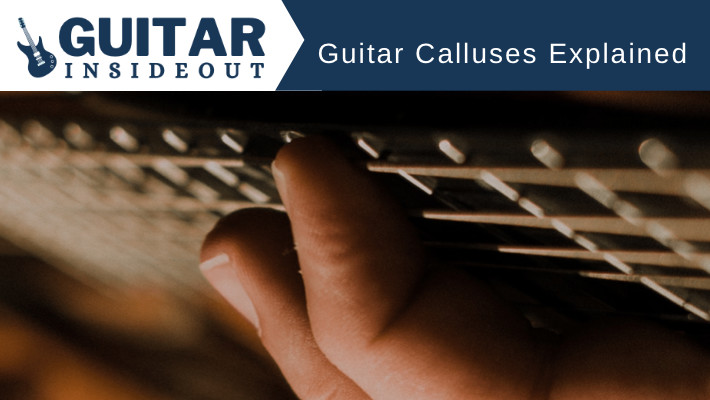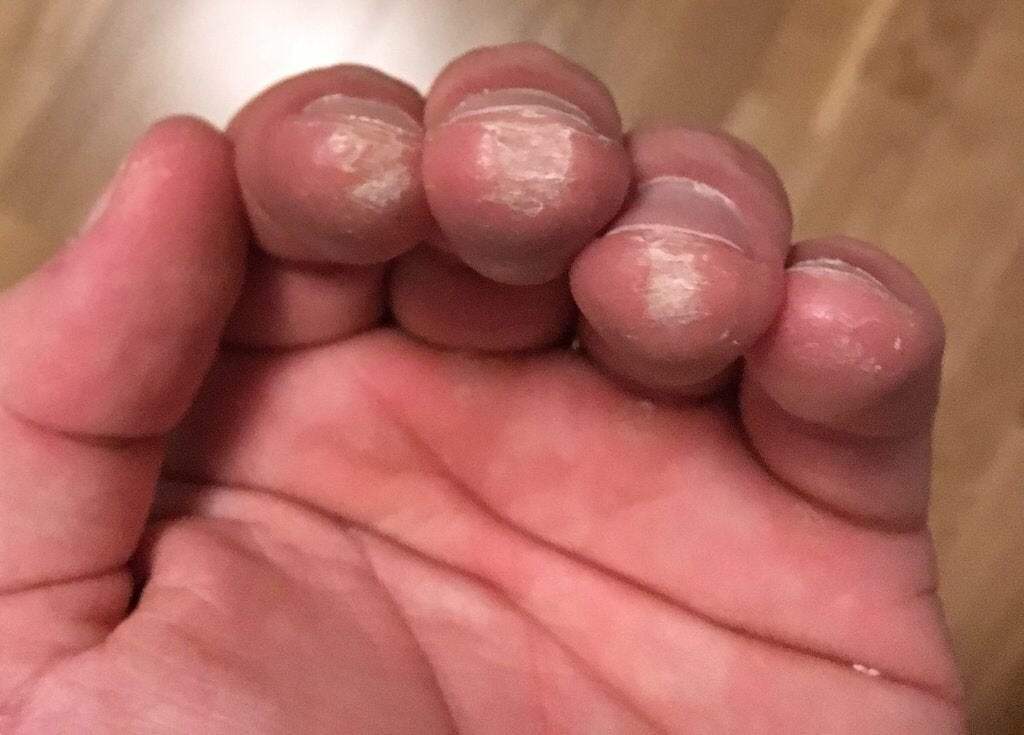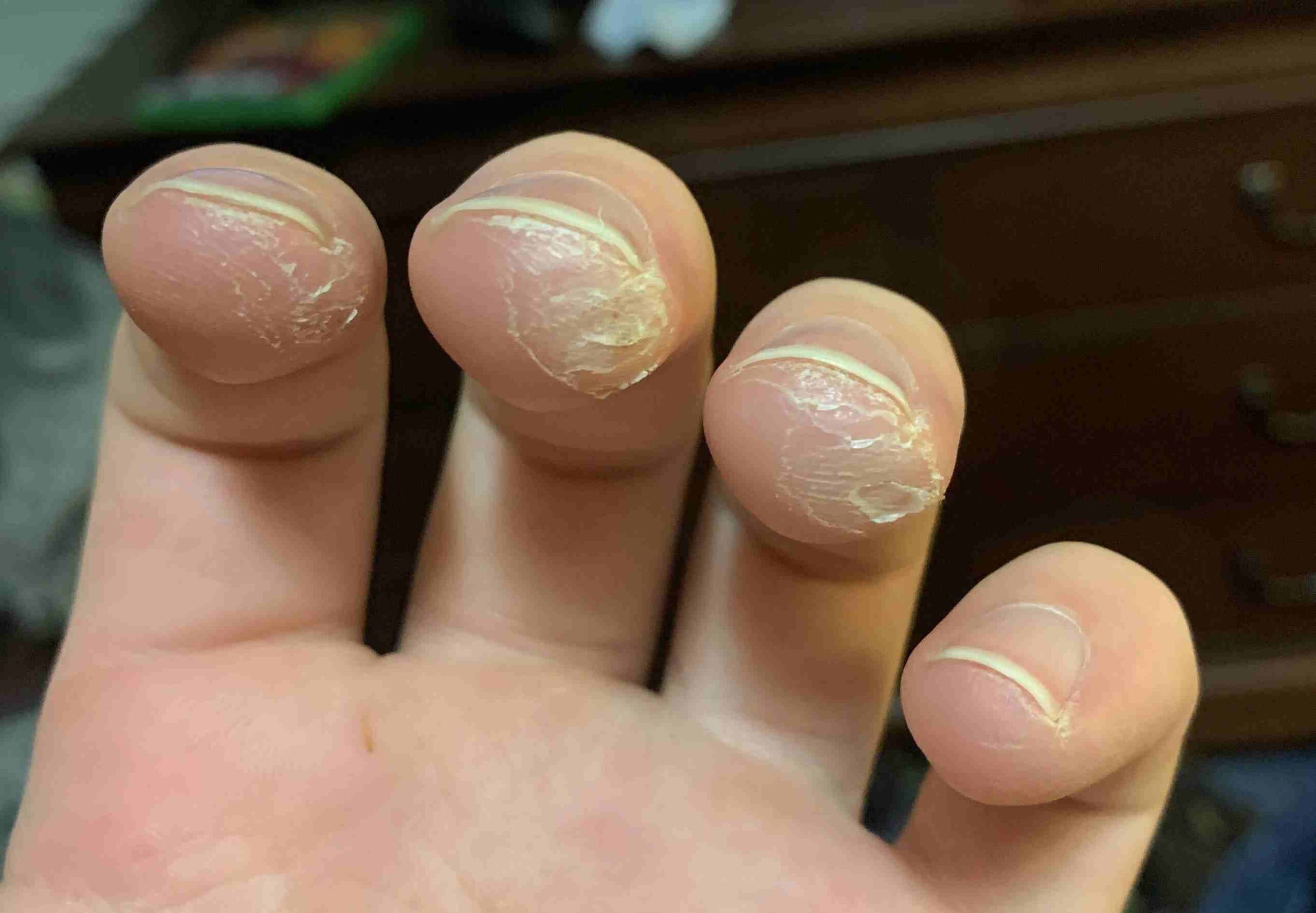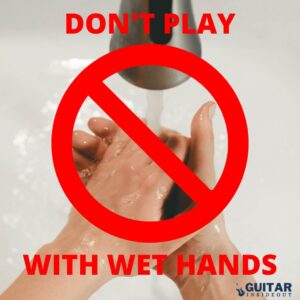
- Guitar calluses are hardened skin on the tips of your fingers.
- You get them from holding down the tough strings on the guitar.
- They help protect your fingers tips and make playing guitar painless.
- Without them holding down the strings would hurt. A lot.
- They develop the more you play and so require consistent practice to get them.
- If you stop playing for a period of time the calluses will go.
For a more in depth look at calluses keep reading.
What are Guitar Calluses
Guitar calluses are pads of skin on the fingertips of your fretting hand that have hardened from use. The more you play and use your fingers the more these hard pads develop and build, which in turn makes playing the guitar and holding down the strings easier and less painful.
Think of them as like little shields on your fingertips to protect you from the uncomfortable strings that dig in.
What do Calluses do
Calluses allow you to play the guitar without any pain. If you’re new to the guitar and tried playing for any length of time you will know how painful it can be to your fingertips.
So the body sensibly and cleverly understands that you’re continuously punishing your fingers by playing the guitar and has a built in defence system. That system is the callus!
When repeatedly stressed the body has learnt to the react to that stress by defending itself and preparing for if it happens again. In the case of calluses the body produces more keratin in the fingertips which thickens the skin.
So over time, and unfortunately a fair amount of pain, your calluses will build and you will be able to play consistently for hours without making your fingers bleed.
Why are they Important?
Guitar calluses are important because if we didn’t have them then no one would be able to play for any prolonged period of time without doing themselves some damage. Think bleeding and very sore fingertips.
They allow you to play the guitar pain free and avoid any discomfort that comes from pushing down on the strings.
Basically they are an essential part of learning to play the guitar and getting more comfortable with the instrument.
How do you get Guitar Calluses
There’s only one way to get guitar calluses: play, play and play! That’s it. There isn’t any special secret.
There are of course ways in which you can play and do exercises to speed up the process and build those calluses more effectively. But essentially the only way to develop guitar calluses is to play your instrument consistently. There are no shortcuts and no ways of cheating.
How long does it take to Develop Guitar Calluses
It all comes down to how much time and effort you’re willing to dedicate to playing. If you play 20 minutes once a week you won’t ever build those calluses.
If you practice consistently every day then you can expect to see some progress fairly quickly. The type of music and guitar you play will also influence the time it takes – acoustic guitar strings are much thicker and require more effort, so help develop calluses quicker.
The usual timeframe is around about a month for calluses to fully build. That assumes you are practicing everyday for 30 or so minutes at least.
If you aren’t physically playing the guitar most days for at least 20-30 minutes then your calluses will either take longer to develop or won’t at all.
Do Guitar Calluses Hurt?
The callus itself doesn’t hurt, but the process of building will hurt, yes. The idea is that you develop your calluses to stop the pain.
It’s just that in order to get calluses you have to go through some pain to get there. No one said learning and playing the guitar would be easy!
If you are finding the pain too intense then you can try lowering the action of your guitar (that’s the height of the strings from the fretboard), using a lighter gauge string, or just practicing in shorter bursts.
Do You Need Them?
If you want to play the guitar for any length of time then yes, they are necessary. Playing for an extended period puts strain and pressure on the soft skin of your fingertips.
The continuous pressing down on the strings is like torture if you don’t have calluses to protect you. So if your aim is to play the guitar for more than a few minutes – maybe you’re joining or starting a band, playing live solo, or just wanting to mess about at home for any length of time – then you will absolutely need to build calluses.
What Part of the Finger are they?
This can sometimes mislead those new to the guitar. You’ve probably learnt that it’s best to hold the strings down with the very tips of your fingers. Well that’s where your calluses should develop.
If you turn your fingertips towards you and look down at them the calluses will form directly below the nail. See the picture below.

They won’t be central to your fingertips at first, as you put more pressure on different parts of the tips at different times. So you can expect to see your calluses building on the outer edge of your tips.
Over time they will probably begin to spread over the entire surface of your fingertips which will help for playing chords from different angles.
How Long do Calluses Last?
Once you’ve got calluses as long as you continue to play the guitar fairly consistently then you will keep them. However, guitar calluses are not permanent. If you stop playing then you will lose and have to rebuild them.
This can happen as quickly as a few weeks if you stop playing entirely. So in order to keep your calluses you’ve got to maintain constant practice and playing.
Do all Guitar Players have Calluses?
Weirdly, no. The vast majority will go through the process of developing calluses when they start to play guitar or come back to it. But there are some who just never seem to need them.
It’s definitely not the norm, and you should work on the basis you will get and need them if you’re just starting out. But everyone is different and some people, for whatever reason, don’t ever develop them.
It may be they already have tough/hard skin. Maybe they moisturize a lot! For some after playing for a year or two the calluses disappear as they learn to play with a very light touch.
Whatever the reason it’s not very common and best to just focus on playing and building yours.
What do Guitar Calluses Look Like
They are thick, hardened pads of skin on the fingertips. At first the skin will look white and almost shredded, to the point where you will probably have a desire to peel it away (don’t do this!).
A picture will do a much better job of demonstrating what they look like, so take a look below:

Tips for Caring for your Finger Calluses
If you’ve persisted through the pain and developed those thick calluses you will understandably want to maintain them. You don’t want to find them disappearing or developing any issues with your fingertips once the hard work is done.
So there are some practical tips you can follow to help care for your calluses.
Don’t Peel or Pick your Calluses
Although it may be so tempting to peel or bite that hard skin off try to avoid doing so. Leaving your calluses alone to do their thing is important.
Yes, they may look a bit ugly and you will probably be aware of them most of the time. But you don’t have to endure it for long and most people find they get used to them quickly as they’re forming.
The only time you may want to do anything about the excess or hard skin if it they begin to catch on strings whilst playing. You don’t want to catch and tear the forming callus as it will be painful and likely stop you from playing for a while as it heals.
But if you do need to file the skin away then use a nail file, emery board or pumice stone. Remember to go slowly and carefully.
Don’t Press the Strings too Hard
When first learning to play the guitar a classic habit a lot of people develop is holding the strings down too hard. We feel like we really need to exert tons of pressure and dig in to maintain the chord or string we are playing.
Not only does this work against us – we tense up and our hands tire quicker – but if can often lead to more serious problems like tendonitis. Or even running our hard work by tearing off our calluses.
Here’s something to consider. Do you already have calluses formed? If yes, do your fingertips still hurt when playing? If so then you’re probably pushing down far too hard.
The answer is to only play as hard as we need to. If you’re struggling with this then place your fingers over the chord you’re going to play but only rest them in the strings. Now push down very slightly until each string is ringing out and not muted. This is the amount of pressure you need to apply.
Try to get into the habit of playing this way and with a lighter touch. It’ll benefit you in multiple ways but mainly help to keep your calluses from getting ruined.
Don’t Play With Wet Hands
Water is the scourge of calluses! When you get your fingers wet you may have noticed the skin becomes a lot softer (and wrinkly!). If you then start playing the guitar when your hands and fingers are still wet or damp the strings are going to dig in to those damp, soft calluses and undo all your hard work.

They will be torn apart or ripped by the strings digging into the dampened, soft fingertips and you’ll be in the position of having to build them up again. So always dry your hands properly and fully before playing the guitar. Or you will end up with ruined calluses and weeks of hard and painful work to get back to where you were.
Tools to Build Calluses
The best way to build guitar calluses is by playing the guitar and practicing efficiently. But there are tools designed to help and speed up the process.
I’m skeptical of how useful these actually are. Much like the grip trainers to improve your finger strength it feels like it would just be a lot easier and beneficial to actually play the guitar.
However if you don’t always have access to your guitar and would like to try and help build your calluses whilst at work then there are some tools that could help.
The Ruff-Grip Callus Building Tool for Guitar Players is affordable and lightweight.

Alternatively you could try some liquid callus formula. This you apply to your fingertips and it creates a callus-like substance that lasts for a few days.
Again, I’m not sure how effective this is but if you were playing a gig and needed a backup solution just in case it couldn’t hurt to keep a bottle with you.

Conclusion
So, now you know all about guitar calluses. How the calluses are developed, why we need them, how to care for and maintain your calluses and more.
They are an essential part of becoming a guitarist and something that shouldn’t be overlooked. But they require hard work on your part.
So whether you’re just starting out on your guitar journey or are already a guitar good but wanted to brush up on your knowledge hopefully you are now a lot better informed about guitar calluses.